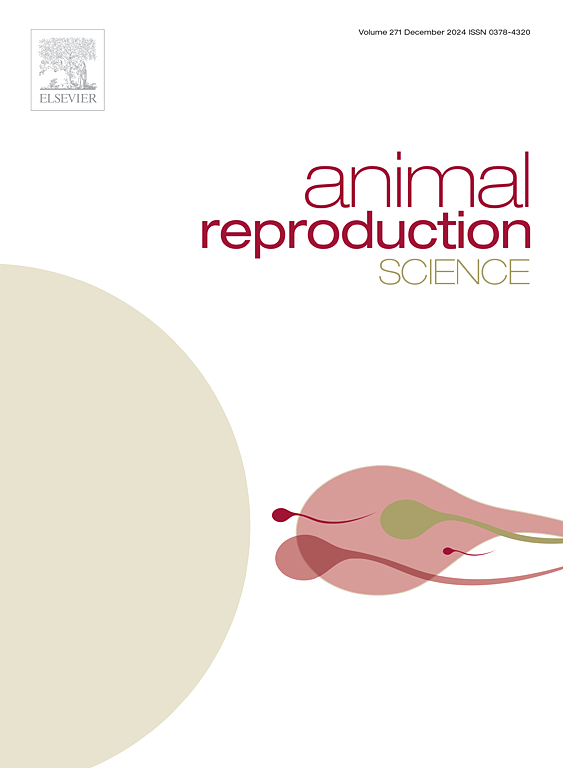Enhancing pregnancy rates in bovine embryo recipients: How equine (eCG) and human (hCG) chorionic gonadotropins affect corpus luteum development
IF 2.2
2区 农林科学
Q1 AGRICULTURE, DAIRY & ANIMAL SCIENCE
引用次数: 0
Abstract
We compared the effects of hCG and eCG treatment on CL development and pregnancy per embryo transfer (P/ET) in beef cows. In Exp.1, non-lactating Nelore cows received either no treatment (Control, n = 13) or 500, 1000, or 2000 IU hCG (n = 12–13/group) two days after ovulation. Luteal area (LA), blood perfusion (BP), and P4 levels were measured for 14 days. In Exp.2, primiparous crossbred cows (n = 889) subjected to a P4/E2 protocol on Day 0 (D0) were assigned to Control (300 IU eCG on D9), eCG/2x (150 IU eCG on D7 and D9), hCG (300 IU eCG on D9 +1000 IU hCG on D14), or eCG/2x+hCG groups. Dominant follicle (DF) size, LA, BP, and P4 were measured, and fresh blastocysts were transferred on D18. In Exp.1, accessory CL (aCL) rate differed (P < 0.05) among treatment groups (C, 0 %C; hCG-500, 8 %BC; hCG-1000, 61.5 %A; hCG-2000, 41.6 %AB). Total LA was greater (P < 0.05) in hCG-1000 and hCG-2000 than in Control. BP did not differ significantly (P > 0.1). P4 concentration was higher (P = 0.04) from day 6–12 in the hCG-1000 and hCG-2000 groups. In Exp.2, eCG/2x increased DF size (P = 0.07), and combined hCG and eCG/2x treatments increased LA (P < 0.01). Combining hCG with eCG/2x; however, reduced BP (P = 0.01). P/ET was higher (P = 0.01) in eCG/2x and hCG groups than in Control at 28- and 60–150-days post-ET. In conclusion, ≥ 1000 IU hCG improves LA, P4, and P/ET but not BP. Administering eCG twice enhances DF and P/ET but combining eCG and hCG is not suggested due to reduced BP without further improving P/ET.
提高牛胚胎受体的妊娠率:马(eCG)和人(hCG)绒毛膜促性腺激素如何影响黄体发育
我们比较了hCG和eCG处理对肉牛CL发育和胚胎移植妊娠(P/ET)的影响。在试验1中,未泌乳的Nelore奶牛在排卵后2天不接受任何治疗(对照组,n = 13)或500、1000或2000 IU hCG (n = 12-13 /组)。测定14 d黄体面积(LA)、血流灌注(BP)、P4水平。在实验2中,在第0天(D0)采用P4/E2方案的初产杂交奶牛(n = 889)被分为对照组(D9心电图300 IU)、eCG/2x组(D7和D9心电图150 IU)、hCG组(D9心电图300 IU + D14 hCG 1000 IU)或eCG/2x+hCG组。测定显性卵泡(DF)大小、LA、BP和P4,并在D18上移植新鲜囊胚。在表1中,各治疗组间副CL (aCL)率差异有统计学意义(P <; 0.05)(C, 0 %C;人类绒毛膜促性腺- 500,公元前8 %;人类绒毛膜促性腺- 1000,61.5 %;人类绒毛膜促性腺- 2000,41.6 % AB)。hCG-1000和hCG-2000组总LA高于对照组(P <; 0.05)。BP无显著差异(P >; 0.1)。在第6-12天,hCG-1000和hCG-2000组P4浓度较高(P = 0.04)。在Exp.2中,eCG/2x治疗增加了DF大小(P = 0.07),hCG和eCG/2x联合治疗增加了LA (P <; 0.01)。hCG联合eCG/2x;血压降低(P = 0.01)。在ET后28天和60 - 150天,eCG/2x组和hCG组P/ET高于对照组(P = 0.01)。结论:≥ 1000 IU hCG可改善LA、P4和P/ET,但不能改善BP。两次eCG可提高DF和P/ET,但由于血压降低而不能进一步改善P/ET,因此不建议合并eCG和hCG。
本文章由计算机程序翻译,如有差异,请以英文原文为准。
求助全文
约1分钟内获得全文
求助全文
来源期刊

Animal Reproduction Science
农林科学-奶制品与动物科学
CiteScore
4.50
自引率
9.10%
发文量
136
审稿时长
54 days
期刊介绍:
Animal Reproduction Science publishes results from studies relating to reproduction and fertility in animals. This includes both fundamental research and applied studies, including management practices that increase our understanding of the biology and manipulation of reproduction. Manuscripts should go into depth in the mechanisms involved in the research reported, rather than a give a mere description of findings. The focus is on animals that are useful to humans including food- and fibre-producing; companion/recreational; captive; and endangered species including zoo animals, but excluding laboratory animals unless the results of the study provide new information that impacts the basic understanding of the biology or manipulation of reproduction.
The journal''s scope includes the study of reproductive physiology and endocrinology, reproductive cycles, natural and artificial control of reproduction, preservation and use of gametes and embryos, pregnancy and parturition, infertility and sterility, diagnostic and therapeutic techniques.
The Editorial Board of Animal Reproduction Science has decided not to publish papers in which there is an exclusive examination of the in vitro development of oocytes and embryos; however, there will be consideration of papers that include in vitro studies where the source of the oocytes and/or development of the embryos beyond the blastocyst stage is part of the experimental design.
 求助内容:
求助内容: 应助结果提醒方式:
应助结果提醒方式:


